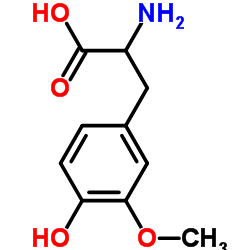The role of 3-O-methyldopa in the side effects of L-dopa.
Eun-Sook Y Lee, Hongtao Chen, Jennifer King, Clivel Charlton
Index: Neurochem. Res. 33(3) , 401-11, (2008)
Full Text: HTML
Abstract
Long-term treatment of L-dopa for Parkinson's disease (PD) patients induces adverse effects, including dyskinesia, on-off and wearing-off symptoms. However, the cause of these side effects has not been established to date. In the present study, therefore, 3-O-methyldopa (3-OMD), which is a major metabolite of L-dopa, was tested to determine whether it plays a role in the aforementioned adverse effects. The effects of 3-OMD on the dopaminergic nervous system in the brain were investigated, by examining behavioral, biochemical, and cellular changes in male Sprague-Dawley rats and catecholamine-producing PC12 neuronal cells. The results revealed that the intracerebroventricular (icv) injection of 1 micromol of 3-OMD impaired locomotor activities by decreasing movement time (MT), total distance (TD), and the number of movement (NM) by 70, 74 and 61%, respectively. The biochemical analysis results showed that a single administration of 1 micromole of 3-OMD decreased the dopamine turnover rate (DOPAC/DA) by 40.0% in the rat striatum. 3-OMD inhibited dopamine transporter and uptake in rat brain striatal membranes and PC12 cells. The subacute administration of 3-OMD (5 days, icv) also significantly impaired the locomotor activities and catecholamine levels. 3-OMD induced cytotoxic effects via oxidative stress and decreased mitochondrial membrane potential in PC12 cells, indicating that 3-OMD can damage neuronal cells. Furthermore, 3-OMD potentiated L-dopa toxicity and these toxic effects induced by both 3-OMD and L-dopa were blocked by vitamin E (alpha-tocopherol) in PC12 cells, indicating that 3-OMD may increase the toxic effects of L-dopa to some extent by oxidative stress. Therefore, the present study reveals that 3-OMD accumulation from long-term L-dopa treatment may be involved in the adverse effects of L-dopa therapy. Moreover, L-dopa treatment might accelerate the progression of PD, at least in part, by 3-OMD.
Related Compounds
| Structure | Name/CAS No. | Molecular Formula | Articles |
|---|---|---|---|
 |
(DL)-3-O-Methyldopa
CAS:7636-26-2 |
C10H13NO4 |
|
Cysteinyl-glycine reduction as marker for levodopa-induced o...
2011-02-15 [Mov. Disord 26 , 543-546, (2011)] |
|
Pharmacokinetic-pharmacodynamic modeling of levodopa in pati...
2010-05-01 [Clin. Neuropharmacol. 33(3) , 135-41, (2010)] |
|
Levodopa infusion combined with entacapone or tolcapone in P...
2012-06-01 [Eur. J. Neurol. 19(6) , 820-6, (2012)] |
|
Comparison of 200 mg retarded release levodopa/carbidopa - w...
2007-01-01 [J. Neural Transm. Gen. Sect. 114(11) , 1457-62, (2007)] |
|
Pharmacokinetic-pharmacodynamic interaction between nebicapo...
2009-10-01 [Clin. Ther. 31(10) , 2258-71, (2009)] |